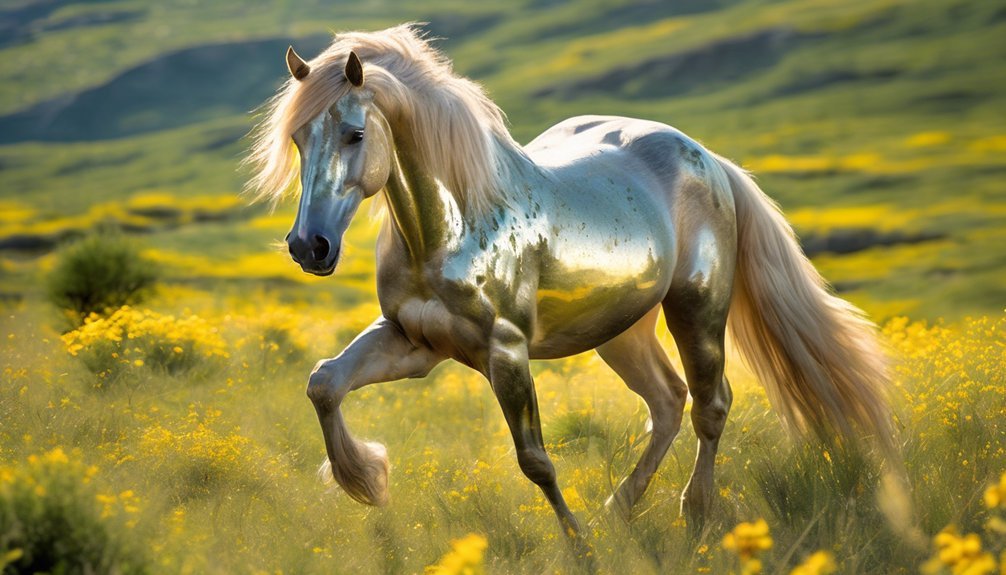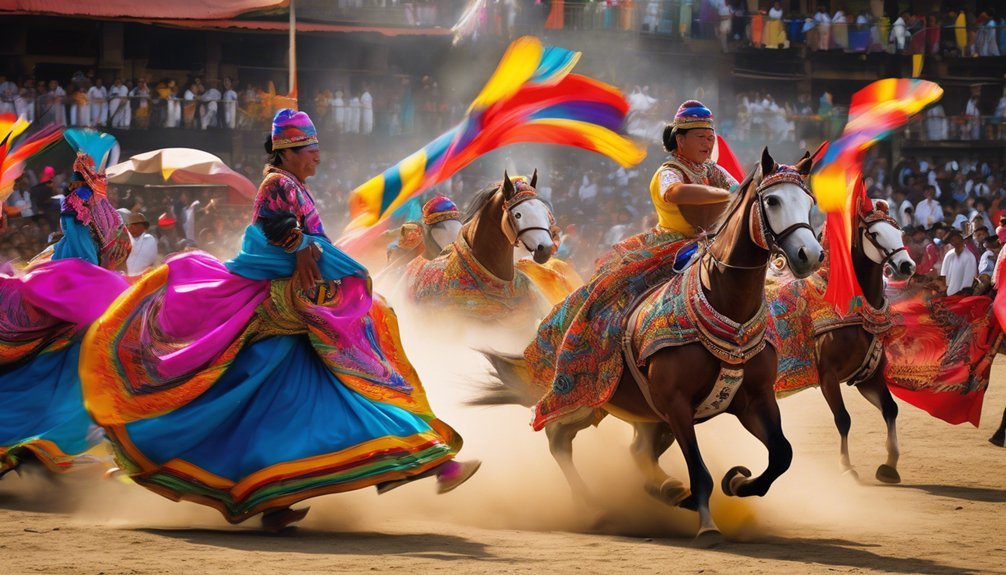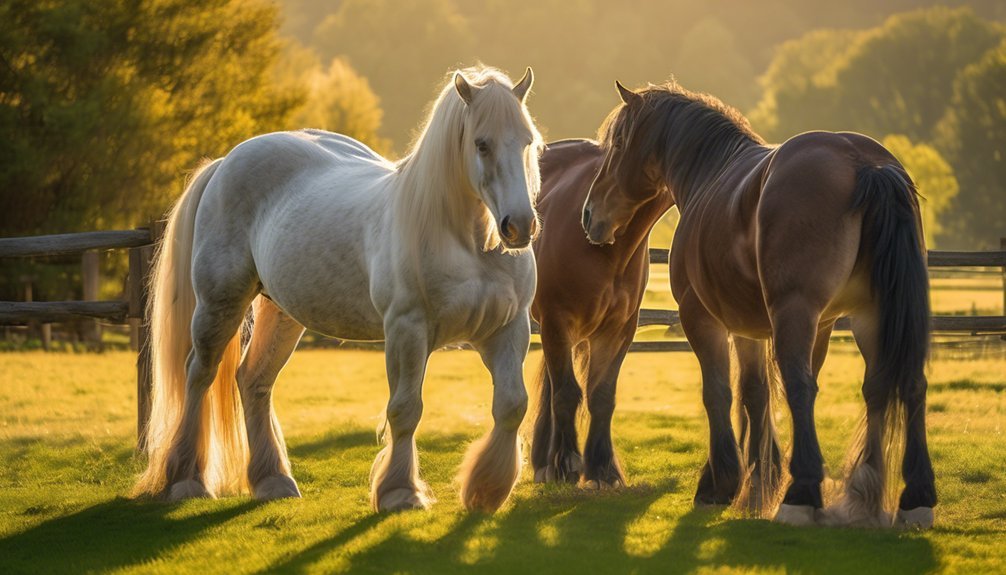
You might think all horses are the same, but the differences between draft and light horses are crucial for your needs. Draft horses bring strength and stability, perfect for heavy work, while light horses offer agility and speed, ideal for riding and competitions. Understanding these distinctions can help you make informed choices for your goals. So, how do you determine which type of horse suits you best?
Key Takeaways
- Draft horses are larger and stronger, ideal for heavy work like plowing and hauling, while light horses are agile and versatile for riding disciplines.
- Common draft breeds include Belgian and Clydesdale, whereas light horse breeds include Arabian and Thoroughbred, each offering unique traits.
- Draft horses excel in pulling contests and parades, while light horses are better suited for trail riding and agility events.
- Care and maintenance differ, with draft horses needing more grooming and a high-quality diet, while light horses require calorie-conscious feeding.
- Temperament varies; draft horses are generally calm and patient, while light horses are energetic and require more stimulation from their handlers.
Overview of Draft Horses

Draft horses, often recognized for their impressive size and strength, play a vital role in agriculture and heavy work. Their history dates back to ancient civilizations, where they were bred for tasks requiring brute force, like plowing fields and hauling heavy loads.
As you explore draft horse uses, you'll find these gentle giants excel in various roles, from farm work to pulling carriages and participating in competitive events. Their calm demeanor makes them exceptional partners for those who appreciate their power and grace.
Understanding their rich history and diverse applications allows you to appreciate the unique bond between humans and these magnificent animals. Whether in a field or a show ring, draft horses continue to showcase their enduring value.
Characteristics of Draft Horses
When you think about draft horses, their impressive physical attributes come to mind, showcasing strength and size.
These horses typically have broad bodies, powerful limbs, and a calm demeanor, which make them exceptional workers.
Understanding their temperament traits is just as important, as it reveals how their gentle nature complements their robust build in various tasks.
Physical Attributes
Mighty and robust, draft horses are easily recognizable by their impressive physical attributes. Their body structure is solid and powerful, often featuring a broad chest and a wide back that exudes strength.
You'll notice their thick, muscular legs, which are designed to carry heavy loads with grace and resilience. The muscle composition in draft horses is dense and well-defined, allowing them to excel in tasks requiring heavy pulling and endurance.
Their height typically ranges from 14.2 to 18 hands, making them one of the largest horse breeds. The combination of these physical traits not only enhances their ability to perform labor-intensive tasks but also showcases their majestic presence, making them a favorite among horse enthusiasts and working farmers alike.
Temperament Traits
The physical strength of draft horses is matched by their temperament, which is characterized by a calm and gentle disposition.
You'll find that these horses exude a tranquil presence, making them excellent companions for both work and leisure. Their calm demeanor allows them to adapt well to various environments, and they often form strong bonds with their handlers.
Despite their robust size, draft horses possess an energetic nature, displaying enthusiasm during tasks and activities.
This blend of steadiness and vitality creates a unique charm that draws many horse enthusiasts to them. Understanding these temperament traits helps you appreciate the draft horse's duality—strength coupled with an affectionate spirit, making them truly remarkable animals in the equine world.
Common Draft Horse Breeds
While you might picture a draft horse as a massive creature, many breeds showcase a blend of strength and temperament that makes them ideal for various tasks.
Each breed has unique characteristics that cater to different needs, and it's essential to know them.
- Belgian Draft: Known for their impressive size and gentle nature, perfect for farm work.
- Percheron Draft: Versatile and intelligent, often used for riding and pulling.
- Clydesdale Draft: Famous for their striking appearance and calm demeanor, popular in parades.
- Shire Draft: One of the tallest breeds, renowned for their strength and reliability.
- Suffolk Punch: A lesser-known breed, characterized by their hard work and friendly temperament.
Understanding these breeds can help you choose the right draft horse for your needs.
Overview of Light Horses
Draft horses are remarkable in their own right, but light horses offer a different set of advantages that appeal to a variety of equestrians.
Light horses are generally more agile and versatile, making them ideal for various riding disciplines, from dressage to endurance. You'll find that light horse breeds, such as Thoroughbreds and Arabians, are known for their speed and stamina.
Their lighter build allows for quicker movements and adaptability in different environments. These horses often exhibit strong personalities, providing a unique bond with their riders.
Whether you're seeking a competitive partner or a leisurely companion, understanding light horse characteristics can help you choose the right horse for your needs and aspirations.
Characteristics of Light Horses
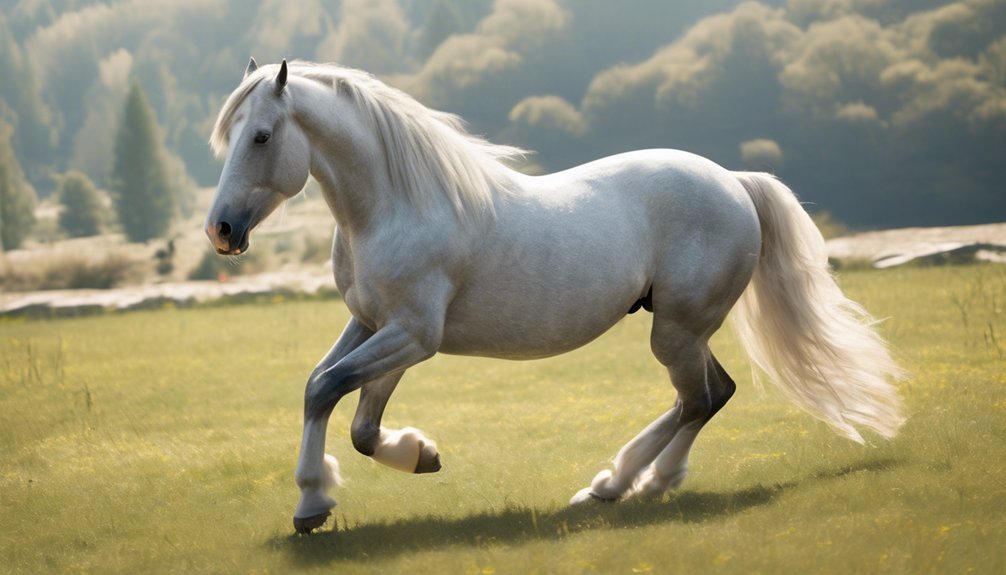
Light horses are celebrated for their agility, speed, and versatility, making them a popular choice among equestrians.
These majestic animals exhibit a range of characteristics that highlight their unique traits, particularly their speed capabilities and agility factors.
- Generally weigh between 900 to 1,400 pounds
- Stand between 14 to 17 hands high
- Possess a lean, athletic build
- Quick reflexes and sharp instincts
- Adaptable to various disciplines, from racing to dressage
Their combination of strength and finesse allows you to enjoy a thrilling ride, whether you're galloping across a field or navigating an obstacle course.
Understanding these characteristics will help you appreciate why light horses are such cherished companions in the equestrian world.
Common Light Horse Breeds
When it comes to common light horse breeds, several stand out for their unique qualities and capabilities.
Arabian horses, known for their endurance and beauty, have captured the hearts of many equestrians.
Then there are Thoroughbred horses, celebrated for their speed and agility, making them a favorite in Thoroughbred racing.
If you're looking for versatility, the Quarter Horse excels in various disciplines, from rodeo events to pleasure riding.
Lastly, Paint Horses, with their striking coat patterns, aren't only visually appealing but also known for their gentle temperament and athleticism.
Each of these breeds offers something special, whether you seek companionship, competition, or just sheer enjoyment in riding.
Choosing the right one can enrich your equestrian experience immensely.
Purposes of Draft Horses vs. Light Horses
When you consider the roles of draft horses and light horses, it's clear that they serve very different purposes.
Draft horses excel in work and labor, often used for heavy pulling and farm tasks, while light horses shine in recreational and sport activities, like riding and racing.
Understanding these distinctions can help you appreciate the unique contributions each type of horse makes.
Work and Labor Roles
Draft horses and light horses serve distinct roles in the world of work and labor, each tailored to specific tasks that showcase their unique strengths.
Draft horses excel in high-labor intensity jobs where sheer power is essential, while light horses shine in tasks requiring agility and speed. Understanding their differences helps you appreciate how each horse contributes to work efficiency.
- Draft horses pull heavy loads and plow fields.
- Light horses are ideal for quick transportation and herding.
- Draft breeds can endure rigorous, demanding tasks.
- Light breeds thrive in versatile roles, including farm work and trail rides.
Each type enhances productivity through specialized skills, creating a dynamic balance in agricultural and labor settings.
Recreational and Sport Uses
While both draft horses and light horses can bring joy and excitement to recreational activities and sports, they cater to different interests and skill levels.
If you're into leisurely recreational riding, light horses are often your best bet. Their agility and responsiveness make for a more dynamic experience on trails or in arenas.
On the other hand, if you're drawn to competitive events like pulling contests or parades, draft horses shine with their strength and impressive presence. They can handle heavy loads and showcase their power in ways that light horses simply can't.
Ultimately, knowing your goals and preferences will guide you in choosing the right horse for your recreational and sporting adventures.
Care and Maintenance Requirements
Caring for horses, whether draft or light, requires a tailored approach that considers their unique needs.
Draft horses often need more intensive grooming techniques due to their thick coats, while light horses might require less frequent grooming but still benefit from regular attention.
Feeding guidelines differ too; draft horses thrive on high-quality forage and grain, while light horses may need a more calorie-conscious diet to prevent obesity.
- Maintain a regular grooming schedule to promote healthy skin.
- Adjust feeding portions based on activity level and body condition.
- Provide adequate shelter to protect against extreme weather.
- Schedule regular veterinary check-ups for preventative care.
- Ensure consistent exercise to keep them fit and happy.
Understanding these specific care requirements will strengthen your bond with your horse.
Training Differences Between Draft and Light Horses
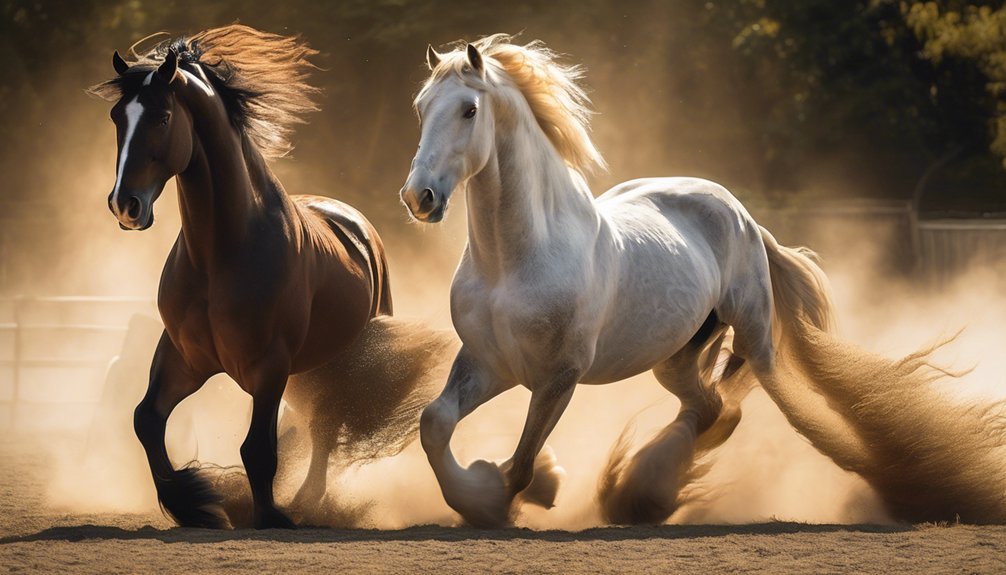
When it comes to training, draft and light horses require different approaches that reflect their unique strengths and temperaments.
You'll find that draft horses often need a focus on physical strength and patience, while light horses benefit from more agility-based techniques and a quicker pace.
Understanding these differences can enhance your training effectiveness and strengthen your bond with each type of horse.
Physical Strength Requirements
Understanding the physical strength requirements for training draft versus light horses is crucial, as these differences significantly impact their development and performance.
Draft horses, built for heavy load capacity, require training that emphasizes muscle development through strength-building exercises. In contrast, light horses, known for their agility and speed, benefit from training focused on endurance and flexibility.
- Draft horses need gradual increases in weight for pulling exercises.
- Light horses thrive on varied terrain for stamina building.
- Consistent conditioning is vital for both types to prevent injuries.
- Nutrition plays a key role in muscle development for both horses.
- Tailored training regimens ensure optimal performance according to each horse's unique strengths.
Understanding these needs helps you nurture their abilities effectively.
Temperament and Behavior
Many horse owners find that temperament and behavior play a significant role in training draft and light horses. Understanding these temperament variations and behavior differences can enhance your training experience.
| Category | Draft Horses | Light Horses |
|---|---|---|
| Temperament | Generally calm and patient | More energetic and spirited |
| Social Behavior | Often more herd-oriented | Tend to be independent |
| Learning Style | Respond well to routine | Thrive on variety and challenges |
Draft horses' steadiness makes them easier to handle, while light horses often require more stimulation. Recognizing these differences helps you tailor your training approach, fostering a deeper bond with your horse. Embrace their unique traits for a fulfilling training journey!
Training Techniques Comparison
Although both draft and light horses serve unique purposes, their training techniques differ significantly due to their contrasting temperaments and physical capabilities.
You'll find that understanding these differences can enhance your training experience.
- Draft horses often require patience, responding well to gentle, consistent training methods.
- Light horses thrive on variety and mental stimulation, benefiting from quick-paced training sessions.
- Recognizing horse behavior is crucial; draft horses may show stubbornness, while light horses often display eagerness.
- Drafts necessitate strength-oriented exercises, while lights excel in agility and finesse tasks.
- Building a bond through trust is essential for both, but the approach may vary to suit their unique needs.
Choosing the Right Horse for Your Needs
When it comes to choosing the right horse for your needs, how do you know which type will best suit your lifestyle and goals? Understanding horse suitability is crucial.
If you're looking for a companion for leisurely trail rides or competitive events, light horses might be your best bet. Their agility and speed cater to varied riding preferences.
On the other hand, if you need a powerful workhorse for heavy farm tasks or pulling, draft horses excel in strength and endurance.
Assess your daily activities, riding goals, and even your level of experience. A well-matched horse can enhance your bond and riding experience, making it essential to choose wisely.
Your horse should feel like a partner in your journey, not just a means to an end.
Frequently Asked Questions
What Is the Average Lifespan of Draft Horses Compared to Light Horses?
When considering lifespan factors, draft horses typically live 15-20 years, while light horses often reach 25-30 years. Breed variations play a significant role, so it's crucial to understand the specific breeds involved.
Do Draft Horses Require More Food Than Light Horses?
When you think of draft horses, imagine gentle giants needing hearty meals. Their caloric intake is higher due to their size and energy demands, so you'll find their feeding habits reflect that robust appetite compared to lighter breeds.
Can Light Horses Be Used for Heavy Farm Work?
While light horses can handle some farm work, their versatility shines in tasks requiring agility. For heavy jobs, they may lack efficiency compared to draft horses, but they bring charm and adaptability to various farming activities.
How Do Draft and Light Horses Differ in Terms of Temperament?
When considering temperament, you'll find draft horses often exhibit a calm demeanor, making them reliable companions. In contrast, light horses tend to showcase an energetic personality, bringing excitement and agility to their interactions with you.
Are Draft Horses More Prone to Certain Health Issues Than Light Horses?
Imagine a sturdy oak, strong yet vulnerable. Draft horses often face unique health conditions due to breed predispositions, like joint issues or metabolic disorders. Understanding these challenges helps you care for them better, ensuring their well-being.
Conclusion
In summary, understanding the differences between draft and light horses is crucial for anyone looking to choose the right equine partner. Did you know that draft horses can weigh between 1,600 to 2,200 pounds, while light horses typically weigh around 900 to 1,300 pounds? This stark contrast highlights their unique purposes and capabilities. Whether you need a powerhouse for heavy tasks or an agile companion for riding, knowing these distinctions will ensure you find the perfect fit for your needs.




